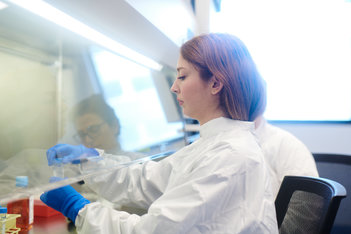Schwartz Family Facility
Randi and Brian Schwartz Family Cancer Immunotherapy and Cell Manipulation Facility

This state-of-the-art laboratory expands BIDMC’s clinical research capacity with the goal of accelerating the delivery of new immunotherapies to patients with cancer. The Center also serves as a manufacturing facility in which BIDMC's physician-scientists produce innovative immune-based treatments, including a promising experimental therapeutic vaccine against several forms of blood cancer.
To ensure the production of safe and effective therapeutic anti-cancer vaccines, the 3,400 square foot suite features three tissue culture rooms comprising 1,900 square feet of clean space designed to achieve "Good Manufacturing Practice" specifications.
Cancer Vaccine Manufacturing Step by Step
Our Center manufactures experimental therapeutics to treat several forms of blood cancer, including acute myeloid leukemia and multiple myeloma. The vaccines created here stimulate the patient’s immune system to eliminate the disease. Many patients who have received cancer vaccines made at BIDMC are still in remission several years later. See the step-by-step manufacturing process below.
